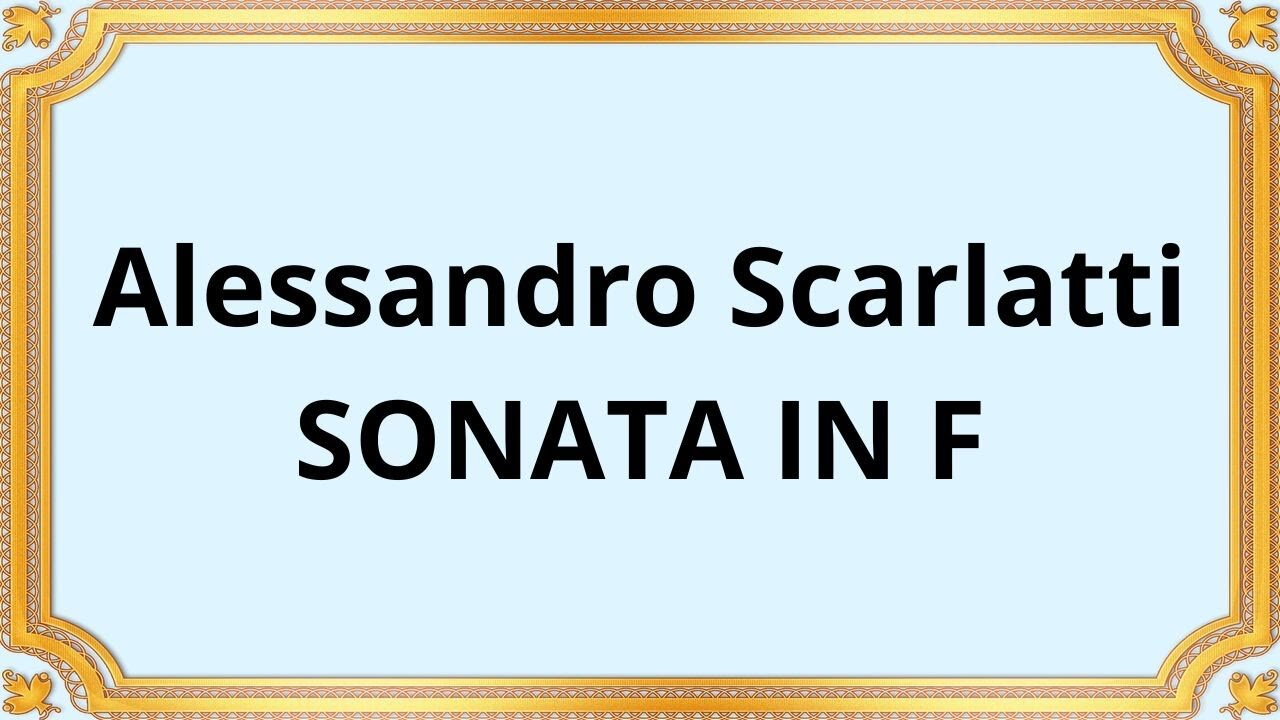Alessandro Scarlatti SONATA IN F major
#AlessandroScarlatti #SonataInFmajor #ClassicalMusic #MusicalComposition #BaroqueEra #BaroqueMusic
Magna Svendsen, recorder
Ole Kinch and Lis Fagerlund, violins
H. Grabow Petersen, cello
Jorgen Ernst Hansen, virginal
Alessandro Scarlatti, an influential Italian composer of the Baroque era, left a lasting impact on the world of classical music. Among his notable works, the Sonata in F Major stands as a testament to his compositional mastery.
Alessandro Scarlatti, active during the late 17th and early 18th centuries, was a prolific composer who contributed significantly to the development of Baroque music. Serving as the court composer for various European nobility, Scarlatti's works were celebrated for their technical brilliance and emotional depth. The Sonata in F Major, composed in the early 18th century, reflects the musical trends and stylistic nuances of the time.
Scarlatti's Sonata in F Major is a shining example of the Baroque style, characterized by its ornate melodies, harmonic complexity, and intricate counterpoint. The composition is structured in multiple movements, typically three or four, each with its distinct mood and musical ideas.
The opening movement, marked Allegro, introduces the listener to a lively and spirited melody. The interplay between different voices, often represented by different instruments or keyboard hands, creates a rich texture and adds depth to the composition. The middle movement, often an Adagio or Largo, provides a moment of introspection and emotional depth. Scarlatti's mastery of harmony shines through in this section, as he weaves together expressive melodies and creates poignant moments of musical tension and release. The final movement, typically a fast-paced Allegro or Presto, showcases Scarlatti's virtuosic writing. It features dazzling runs, intricate ornamentation, and lively exchanges between the various voices, leaving the listener in awe of the composer's technical skill and musical ingenuity.
Alessandro Scarlatti's Sonata in F Major holds immense significance in the realm of Baroque music. Its technical demands, harmonic richness, and expressive qualities demonstrate Scarlatti's exceptional compositional abilities. This composition not only showcases his command over the intricacies of Baroque music but also highlights his ability to create emotionally captivating pieces.
The Sonata in F Major's lasting legacy lies in its enduring popularity and influence on subsequent composers. Scarlatti's innovative use of form, harmonic progression, and melodic invention helped pave the way for future developments in classical music. Many composers, including his son Domenico Scarlatti, were inspired by Alessandro's works and built upon his musical language.
Conclusion:
Alessandro Scarlatti's Sonata in F Major stands as a testament to his remarkable talent and the richness of Baroque music. Its ornate melodies, intricate counterpoint, and harmonic complexity captivate listeners and provide an insight into the musical world of the time. Scarlatti's ability to infuse emotion and technical brilliance into his compositions further solidifies his place as a distinguished figure in the history of classical music. As we delve into the depths of the Sonata in F Major, we are reminded of the enduring legacy of Alessandro Scarlatti and his significant contributions to the world of music.
You have the opportunity to support the channel:
https://destream.net/live/RadSiarAl/donate
https://www.buymeacoffee.com/6355radsiaral
-
 6:07
6:07
Classical music_Music Inspiration
19 days agoJoseph Haydn Piano Sonata in D Major, Hob. XVI:51
701 -
 LIVE
LIVE
The StoneZONE with Roger Stone
2 hours agoTrump’s Divine Presidency: Pastor Randy Coggins II on Faith, Family, Freedom | The StoneZONE
522 watching -
 LIVE
LIVE
VOPUSARADIO
1 day agoPOLITI-SHOCK! SPECIAL 8 PM EST START! "TRANSFOMATIVE CHANGE IS COMING"! END THE FED!!
66 watching -
 1:08:03
1:08:03
Kimberly Guilfoyle
6 hours agoLIVE COVERAGE TRUMP-MODI MEETING | Ep.196
72.8K19 -
 1:26:45
1:26:45
Redacted News
4 hours agoPANIC in Germany: Scholz RAGES as Trump & Putin Push Ukraine Peace Deal, RFK CONFIRMED | Redacted
122K178 -
 LIVE
LIVE
Quite Frankly
7 hours ago"RFK's Moment, Gold Rush, Wendy Williams Shocker, MORE!" ft. Tony Arterburn, Lauren Conlin 2/13/25
1,592 watching -
 DVR
DVR
Common Threads
3 hours agoLIVE DEBATE: Time to Delete Entire Agencies?
3.79K -

theDaily302
11 hours agoThe Daily 302 - Colonel Roxane Towner Watkins
13.1K1 -
 1:02:24
1:02:24
In The Litter Box w/ Jewels & Catturd
1 day agoGULF OF AMERICA | In the Litter Box w/ Jewels & Catturd – Ep. 741 – 2/13/2025
80.8K54 -
 2:02:16
2:02:16
Revenge of the Cis
5 hours agoEpisode 1446: Repent Fatty
42.7K6
